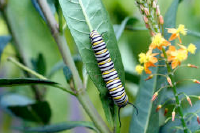
The words "Butterfly Garden" evoke a certain image – drifts of color and mounds of blooms with happy butterflies flitting from flower to flower sipping sweet nectar. We envision coneflowers, buddleias, lantana, phlox, pentas, and cestrum. Butterfly gardens are lovely, and have become a necessity to support these species in heavily urbanized areas.
Much attention is paid to providing nectar plants – food for the adults - and this is a good thing. However, too often we are forgetting that these jewels of our garden depend on specific plants to feed their next generation. We need to provide host plants for the caterpillars.
Providing host plants means that we have to change our mindset a bit. We will have to increase our tolerance for "damage" and we can't run for the sprayer the minute we see "bugs" eating our plants. We actually want the caterpillars to devour these plants, grow, pupate, and emerge again as beautiful adults.
Happily, many of these plants are beautiful in our gardens throughout the rest of the year after the caterpillars have had their fill. Some may even benefit from this cycle, even though it seems at the time that nothing could survive the onslaught of hungry larvae.
We had a row of three Catalpas several years ago. Only one served as host to the Catalpa worm – larval form of the Catalpa sphinx moth. The plant was virtually stripped of leaves that summer but it came back with a vengeance the following year and surpassed the untouched trees in size and vigor for several years afterward. Nature is amazing and resilient.
One of the best known host plants in the area is the Mexican butterfly weed (Asclepias curassavica). This member of the milkweed family is host to the monarch butterfly. This plant should be planted in drifts of five to seven plants and should be located in several places in the garden. Serious butterfly garden enthusiasts often have a second planting growing in reserve just in case the first crop is decimated before the larvae have reached full size. The caterpillars can be gently lifted from one plant and moved another. Once the plants have been eaten down, they can be cut back by half. They will flush out again, ready for the next round.
Citrus is host to several swallowtail butterflies including the giant swallowtail. The caterpillar is known as the "orange dog." It's an odd looking fellow with a threatening behavior when disturbed, but they are quite harmless. Yes, it will eat a bit of citrus foliage, but the damage is temporary and not devastating to the plant.
If you have a small yard, or wish to bring nature up close on a patio, consider the Australian finger lime. This unique citrus is highly ornamental in a large container and is a favorite of the giant swallowtail. The foliage is small and airy, the tiny blooms are fragrant, and it can be pruned to your desired height and width. The fruit is interesting as well – long, fingerlike fruits that contain tart, juicy pearls that are known as "citrus caviar". They are most often served with fish.
The caterpillars of the sulphur butterflies caused quite a ruckus at the nursery last year. They were plentiful and beautiful and we visited the large cassia shrubs every day just to watch them grow. Flowering senna (Cassia corymbosa) has so much going for it. It has delicate, dark green pea-like foliage and buttery yellow flowers over a long bloom period. It's drought tolerant and has been tolerant of most soil types. To get the most benefit as a host plant it is best planted in multiples.
Passionvines (Passiflora) are host to the Gulf fritillary caterpillars. Passionvines are available in so many colors – white, blue, lavender, purple, pink, red. They grow quickly to cover arbors, trellises and fences. The caterpillars will devour the vines almost to the roots, but they will flush back out as soon as the larvae leave to pupate. Not all varieties attract butterflies, but opinions differ on which are best. We have had reports that the red-flowered varieties do not serve as host plants for various reasons, but we have had gardeners report that they have red-flowered vines covered with larvae. I think we write rules that nature refuses to read.
The pipevine swallowtail is another butterfly that is easily provided for in our area. There are a variety of Dutchman's pipe vines that grow very well for us from the diminutive Fimbriata Dutchman's pipe (Aristolchia fimbriata) to the Giant Dutchman's pipe (Aristolochia gigantea). Fimbriata is very versatile. It will grow in containers and hanging baskets as well as in the ground. It will grow in filtered or part shade, but has trailed out in full sun for us and done quite well. Swallowtails seem to prefer fimbriata over some of the larger varieties.
There are simply too many pairings for us to cover here. A good reference for selecting host and nectar plants for the butterflies in your area can be found at www.naba.org. Go to Butterfly Gardening, click on Regional Garden Guides, then click on Houston. You will be linked to a list of nectar and host plants for the Central Gulf Coast.
This column is produced by Urban Harvest. Learn about gardening classes, community gardens and orchards, farmers markets and more at the Urban Harvest website. This article was written by Angela Chandler, who is a freelance garden writer and speaker and Heidi Sheesley, who is the owner of TreeSearch Farms Inc., a wholesale grower of perennials, natives and unique plants.